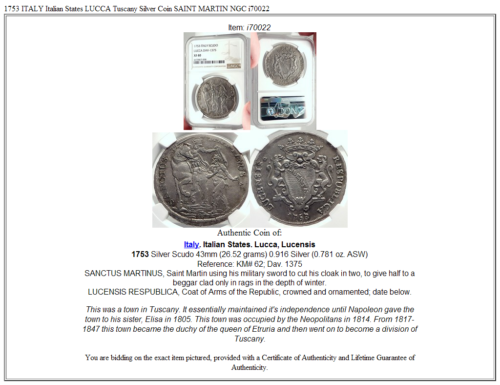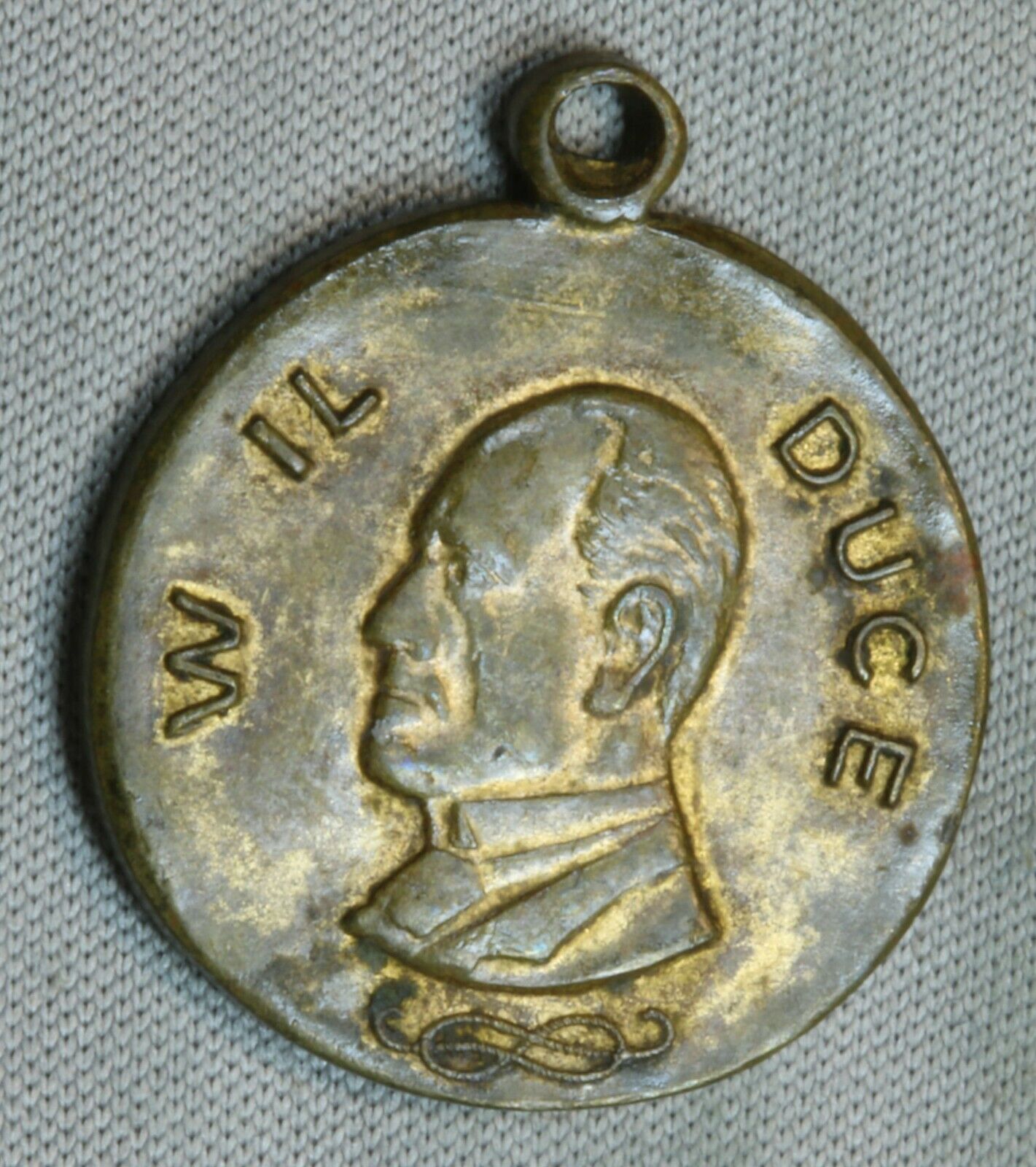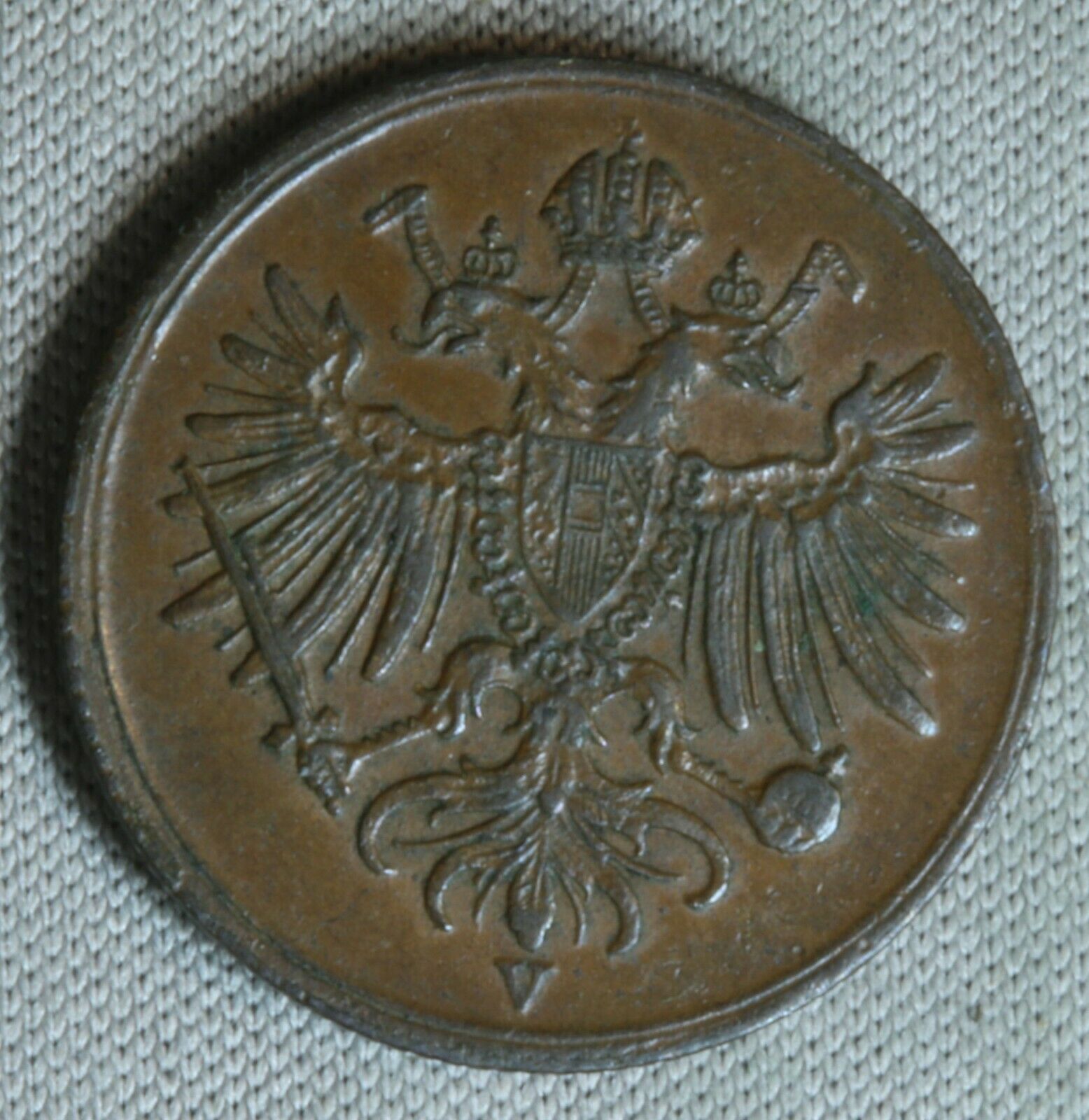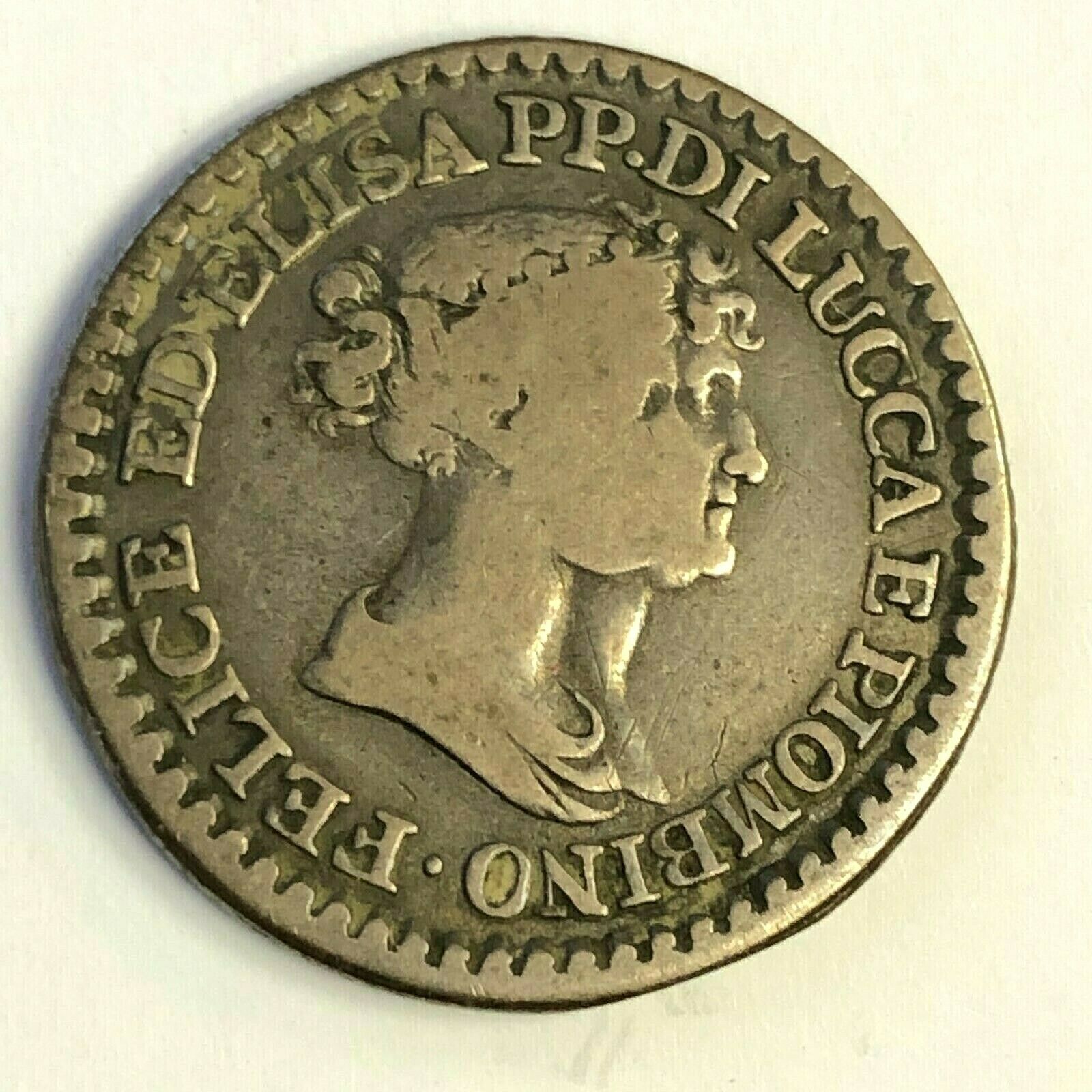-40%
1753 ITALY Italian States LUCCA Tuscany Silver Coin SAINT MARTIN NGC i70022
$ 632.96
- Description
- Size Guide
Description
Item:i70022
Authentic Coin of:
Italy
. Italian States. Lucca, Lucensis
1753
Silver Scudo 43mm (26.52 grams) 0.916 Silver (0.781 oz. ASW)
Reference: KM# 62; Dav. 1375
SANCTUS MARTINUS, Saint Martin using his military sword to cut his cloak in two, to give half to a beggar clad only in rags in the depth of winter.
LUCENSIS RESPUBLICA, Coat of Arms of the Republic, crowned and ornamented; date below.
This was a town in Tuscany. It essentially maintained it's independence until Napoleon gave the town to his sister, Elisa in 1805. This town was occupied by the Neopolitans in 1814. From 1817-1847 this town became the duchy of the queen of Etruria and then went on to become a division of Tuscany.
You are bidding on the exact item pictured, provided with a Certificate of Authenticity and Lifetime Guarantee of Authenticity.
Martin of Tours
(Latin:
Sanctus Martinus Turonensis
; 316 - 8 November 397) was Bishop of Tours, whose shrine in France became a famous stopping-point for pilgrims on the road to Santiago de Compostela in Spain. He has become one of the most familiar and recognisable Christian saints. As he was born in what is now Szombathely, Hungary, spent much of his childhood in Pavia, Italy, and lived most of his adult life in France, he is considered a spiritual bridge across Europe.
His life was recorded by a contemporary, the hagiographer Sulpicius Severus. Some of the accounts of his travels may have been interpolated into his
vita
to validate early sites of his cult. He is best known for the account of his using his military sword to cut his cloak in two, to give half to a beggar clad only in rags in the depth of winter. Conscripted as a soldier into the Roman army, he found the duty incompatible with the Christian faith he had adopted and became an early conscientious objector.
San Martín y el mendigo
by El Greco
Legend of Martin's cloak
While Martin was a soldier in the Roman army and deployed in Gaul (modern-day France), he experienced a vision, which became the most-repeated story about his life. One day as he was approaching the gates of the city of Amiens, he met a scantily clad beggar. He impulsively cut his military cloak in half to share with the man. That night, Martin dreamed of Jesus wearing the half-cloak he had given away. He heard Jesus say to the angels: "Martin, who is still but a catechumen, clothed me with this robe." (Sulpicius, ch 2). In another version, when Martin woke, he found his cloak restored to wholeness. The dream confirmed Martin in his piety, and he was baptised at the age of 18.
The part kept by himself became the famous relic preserved in the oratory of the Merovingian kings of the Franks at the Marmoutier Abbey near Tours.
[2]
During the Middle Ages, the supposed relic of St. Martin's miraculous cloak, (
cappa Sancti Martini
) was carried by the king even into battle, and used as a holy relic upon which oaths were sworn. The cloak is first attested in the royal treasury in 679, when it was conserved at the
palatium
of Luzarches, a royal villa that was later ceded to the monks of Saint-Denis by Charlemagne, in 798/99.
The priest who cared for the cloak in its reliquary was called a
cappellanu
, and ultimately all priests who served the military were called
cappellani
. The French translation is
chapelains
, from which the English word
chaplain
is derived.
A similar linguistic development took place for the term referring to the small temporary churches built for the relic. People called them a "capella", the word for a little cloak. Eventually, such small churches lost their association with the cloak, and all small churches began to be referred to as "chapels".
The
Republic of Lucca
was a historic state of Italy, which lasted from 1160 to 1805 on the central Italian peninsula.
History
Medieval era
See also: Italy in the Middle Ages
Within the Imperial Kingdom of Italy, the city of Lucca had been the residence of the Margraves of Tuscany. A certain autonomy was granted by a 1084 diploma issued by Emperor Henry IV, while on his Italian campaign during the Investiture Controversy with Pope Gregory VII. After the death of Margravine Matilda of Tuscany in 1115, the city began to constitute itself an independent commune, with a charter officially acknowledged by Margrave Welf VI in 1160. For almost 500 years, Lucca remained as an independent republic.
There were many minor provinces in the region between southern Liguria and northern Tuscany dominated by the Malaspina family. Tuscany in this time was a part of feudal Europe. The
Divine Comedy
by Dante includes many references to the great feudal families who had huge jurisdictions with administrative and judicial rights. Dante spent some of his exile in Lucca.
In 1273 and again in 1277 Lucca was ruled by a Guelph
capitano del popolo
(captain of the people) named Luchetto Gattilusio. In 1314, internal discord allowed Uguccione della Faggiuola of Pisa to make himself lord of Lucca.
Castruccio Castracani
The Lucchesi expelled him two years later, and handed over the city to another
condottiere
Castruccio Castracani, under whose rule it became a leading state in central Italy. Lucca rivalled Florence until Castracani's death in 1328.
On 22 and 23 September 1325, in the battle of Altopascio, Castracani defeated Florence's Guelphs. For this he was nominated by Louis IV the Bavarian to become duke of Lucca. Castracani's tomb is in San Francesco in Lucca. His biography, by Machiavelli, is the author's third famous book on political rule.
Renaissance and onwards
Occupied by the troops of Louis of Bavaria, the city was sold to a rich Genoese, Gherardino Spinola, and then seized by John, King of Bohemia (1296-1346). Then pawned to the Rossi of Parma, and by them it was ceded to Martino della Scala of Verona. Then sold to the Florentines, surrendered to the Pisans (1342-1368), and then nominally liberated by the emperor Charles IV (son of John, King of Bohemia) and governed by his vicar.
In 1408, Lucca hosted the convocation intended to end the schism in the papacy. Lucca managed, at first as a democracy, and after 1628 as an oligarchy, to maintain its independence - alongside with Venice and Genoa. It painted the word
Libertas
on its banners, until the French Revolution in 1789.
[1]
Lucca was the third largest Italian city state with a republican constitution ("comune") to remain independent over the centuries, as larger Venice and Genoa also did.
End
Early 19th century
Flag of the Jacobin State of Lucca (early 1799 and 1800-05). French democracy
The independent course of the Republic changed in February 1799, after the Second Coalition invasion (1799-1800), one of the Italian campaigns of the French Revolutionary Wars.
French Jacobins created a centralized republic, the State of Lucca, with a democratic constitution. The constitution granted the government to an Executive Directory, with a bicameral legislature composed of the Council of Juniors and the Council of Seniors. The democracy did not last long.
Habsburg regency
Five months later in July 1799, after the French army retreated, forces of the Austrian Habsburg Monarchy conquered the city and established a Provisional government
French republic restored
In late 1800 the French army returned, reconquering Lucca. A new constitution for the State of Lucca was published in 1801, restoring the office of Consul of Justice as the president of the Executive branch, with a parliament called the Great Council.
Napoleonic principality
In 1805, the governance of Lucca was taken over by Napoleon, who merging the State of Lucca with the Principality of Piombino to become the Principality of Lucca and Piombino (1805-1809). He put his favored sister Elisa Bonaparte Baciocchi in place to rule, his only female sibling to gain political power. Elisa began rule as the Duchess of Lucca and Princess of Piombino, based at Villa Reale di Marlia.
See also
Duchy of Lucca -
post-Napoleon (1815-1847)
Grand Duchy of Tuscany -
(1569-1801) and (1815-1859)
Frequently Asked Questions
Mr. Ilya Zlobin
, world-renowned expert numismatist, enthusiast, author and dealer in authentic ancient Greek, ancient Roman, ancient Byzantine, world coins & more.
Who am I dealing with?
You are dealing with Ilya Zlobin, ancient coin expert, enthusiast, author and dealer with an online store having a selection of over 15,000 items with great positive feedback from verified buyers and over 10 years experience dealing with over 57,000 ancient and world coins and artifacts. Ilya Zlobin is an independent individual who has a passion for coin collecting, research and understanding the importance of the historical context and significance all coins and objects represent. Most others are only concerned with selling you, Ilya Zlobin is most interested in educating you on the subject, and providing the largest selection, most professional presentation and service for the best long-term value for collectors worldwide creating returning patrons sharing in the passion of ancient and world coin collecting for a lifetime.
How long until my order is shipped?
Orders are shipped by the next business day (after receipt of payment) most of the time.
How will I know when the order was shipped?
After your order has shipped, you will be left positive feedback, and that date could be used as a basis of estimating an arrival date. Any tracking number would be found under your 'Purchase history' tab.
USPS First Class mail takes about 3-5 business days to arrive in the U.S. International shipping times cannot be estimated as they vary from country to country.
Standard international mail to many countries
does not
include a tracking number, and can also be slow sometimes.
For a tracking number and signature confirmation, you may want to do Express Mail International Shipping, which costs more, however, is the fastest and most secure. Additionally you may be able to receive your order in as little as 3-5 business days using this method. For Express Mail International, it may be possible to place up to 10-15 items in one package (for the one shipping cost) as it is flat rate envelope, which may be the most cost-effective, secure and fastest way to receive items internationally. Send me a message about this and I can update your invoice should you want this method.
Getting your order to you, quickly and securely is a top priority and is taken seriously here.
Great care is taken in packaging and mailing every item securely and quickly.
Please be aware, I cannot take responsibility for any postal service delivery delays, especially for international packages as it may happen in rare instances.
What is a certificate of authenticity and what guarantees do you give that the item is authentic?
Each of the items sold here, is provided with a Certificate of Authenticity, and a Lifetime Guarantee of Authenticity, issued by a world-renowned numismatic and antique expert that has identified over 57,000 ancient coins and has provided them with the same guarantee. You will be very happy with what you get with the COA; a professional presentation of the coin, with all of the relevant information and a picture of the coin you saw in the listing. Additionally, the coin is inside it's own protective coin flip (holder), with a 2x2 inch description of the coin matching the individual number on the COA.
On the free-market such a presentation alone, can be considered a - value all in itself, and it comes standard with your purchases from me,
FREE.
With every purchase, you are leveraging my many years of experience to get a more complete context and understanding of the piece of history you are getting. Whether your goal is to collect or give the item as a gift, coins presented like this could be more prized and valued higher than items that were not given such care and attention to.
Buy a coin today and own a piece of history, guaranteed.
Is there a money back guarantee?
I offer a 30 day unconditional money back guarantee. I stand behind my coins and would be willing to exchange your order for either store credit towards other coins, or refund, minus shipping expenses, within 30 days from the receipt of your order. My goal is to have the returning customers for a lifetime, and I am so sure in my coins, their authenticity, numismatic value and beauty, I can offer such a guarantee.
When should I leave feedback?
Once you receive your order, please leave a positive feedback. Please don't leave any negative feedbacks, as it happens sometimes that people rush to leave feedback before letting sufficient time for their order to arrive. Also, if you sent an email, make sure to check for my reply in your messages before claiming that you didn't receive a response. The matter of fact is that any issues can be resolved, as reputation is most important to me. My goal is to provide superior products and quality of service.
How and where do I learn more about collecting ancient coins?
Visit the "
Guide on How to Use My Store
" for on an overview about using my store, with additional information and links to all other parts of my store which may include educational information on topics you are looking for.













